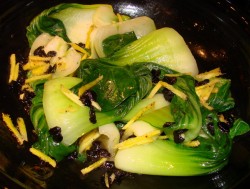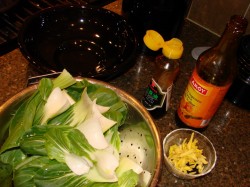Inspired by Kylie Kwong: Bok Choy With Oyster Sauce, Ginger and Fermented Black Beans
Now that I have posted a list of basic Chinese pantry items, I think the next step is to create a series of simple recipes using a minimum of ingredients which just about anyone can recreate. The goal is to simplify Chinese cooking for Americans who have limited access to Asian markets while still making recipes that have the essential flavosr that are expected from Chinese food. In other words, this is my constructive response to Cook’s Illustrated Magazine’s flawed approach to presenting simplified, but inauthentic, Chinese recipes.
My inspiration for this recipe is Kylie Kwong’s Bok Choy with Oyster Sauce from her book Simple Chinese Cooking, but is not exactly as she wrote it. Her version has an even shorter ingredient list than mine; hers was simply bok choy, oyster sauce, sesame oil and peanut oil. To my palate, such a dish would be woefully bland, so I decided to change it considerably, while retaining the basic cooking methods and ideal of keeping a short, basic ingredient list.
The resulting dish, while simple and pure in flavor, was quite delicious and went very well with the Chicken with Cashews.
This is not a stir-fried dish; instead, the bok choy is blanched in boiling water for about one minute. Basically, it is cooked only until the leaves wilt, then it is removed from the cooking water, drained and dressed with the oyster sauce and sesame oil. Kwong then had the cook heat the peanut oil and pour it sizzling over the bok choy, but I went a step farther. I figured if I had to heat up oil, I might as well put something in it, so I added a tablespoon of fermented black beans and a tablespoon and a half of finely shredded fresh ginger. After the flavor of the black beans and ginger infused the oil, then I drizzled the whole crackling, fragrant mixture over the vegetable, then stirred it well.
(If you want a more subtle dish, use less black beans–about a teaspoon instead of a tablespoon, and cut down a bit on the ginger, too, if you like.)
It made a very simple, easily cooked vegetable dish to accompany a stir-fried meat dish. The texture of bok choy cooked in this way is very interesting: it is velvety, with a subtle crunch, but only if you are careful not to overcook it. The sauce makes a thin coating over the bok choy and echoes the smooth mouthfeel of the vegetable without being thick or sticky. The still crisp slivers of ginger add contrasting texture as well as a bit of a fiery flavor, while the salty beans give the entire dish a good dash of “oomph.”
Look for more simple Chinese style recipes here in the future using basic pantry items.
Bok Choy With Oyster Sauce, Ginger and Fermented Black Beans
Ingredients:
3/4 pound baby, young or Shanghai bok choy*, washed
1 teaspoon salt
1 1/2 tablespoons oyster sauce
1/8 teaspoon sesame oil
1 tablespoon peanut or canola oil
1 tablespoon fermented black beans
1 1/2 tablespoons fresh ginger, peeled and cut into thin slivers
Method:
After you have rinsed the bok choy, cut off the bottom core, to separate the leaves. Rinse the leaves well again, and set aside to drain.
Bring a pot of water big enough to hold all of the bok choy to a boil; add the salt and stir to dissolve. Add the leaves, and stir to get all of them under the water. Cook for about one minute; just allow the leaves to wilt and the stems to brighten in color.
Drain well, and place in a warmed serving bowl.
Toss with oyster sauce and sesame oil until leaves are well coated.
Heat peanut or canola oil in a small frying pan or wok. Add fermented black beans and ginger, and stir for about a minute to two minutes. Pour oil, beans and ginger over the bok choy and stir. Serve immediately.
*Note: Use the smaller types of bok choy if possible. Shanghai bok choy has yellow green stems (as opposed to white stems) and emerald green leaves, instead of dark green leaves, and is sweeter in flavor than more typical large white and deep green bok choy.
This basic idea can be used for other Chinese greens such as choy sum or gai lan; adjust cooking times to account for the denser plant tissues of gai lan. (In other words, cook it longer because the stems are thicker and harder than bok choy stems.)
5 Comments
RSS feed for comments on this post.
Sorry, the comment form is closed at this time.
Powered by WordPress. Graphics by Zak Kramer.
Design update by Daniel Trout.
Entries and comments feeds.





It’s a week of freaky coincidences in food blogging for me. A couple of days ago I wrote something for college on Anzac biscuits and then found Tschoeder posting on Anzac biscuits. Yesterday I posted something on orange and then found Haalo blogging on orange. And tonight I posted a reference to Kylie Kwong, who I’d never even heard of before, and…
Comment by Trig — February 26, 2007 #
I forgot to mention last night that I’ve been eating bok choi (or at least its close relative Chinese cabbage) with oyster sauce regularly since first discovering it in a restaurant. I think I’ll see if I can acquire a KK book myself.
Comment by Trig — February 27, 2007 #
Virtual CSA Box: Bok Choy
Bok choy, or Chinese cabbage, is a vegetable that has been cultivated for thousands of years in China, and it shows up with regularity in Chinese and Asian cuisines. It’s also showing up in many CSA boxes! If you…
Trackback by Apartment Therapy Food — August 2, 2007 #
YUMMMM …i know way late but just found and adore your asian stuff!eating this as we speak & i also have kylie’s book!was looking for recipes like these for a loooong time!
thanks!
Comment by niccii — May 20, 2011 #
You are welcome, niccii–and late is only a matter of perception!
Comment by Barbara — May 23, 2011 #